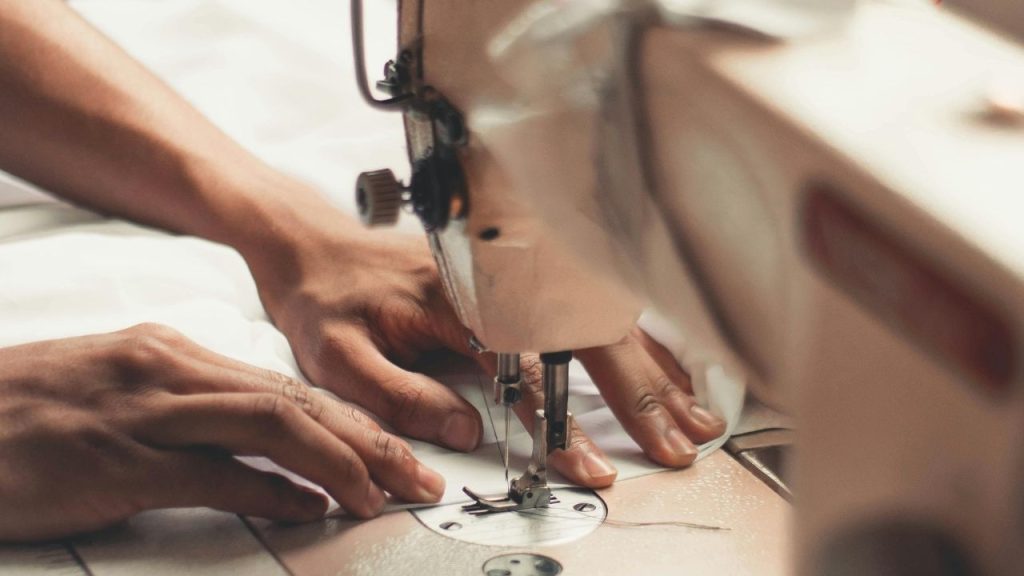Sewing machines, while reliable, can sometimes run into issues that disrupt your sewing projects. Many of these problems can be easily fixed with a little troubleshooting. Here’s an article on how to address some of the most common sewing machine issues.

1. Thread Bunching Under the Fabric (Bird Nesting)
Symptoms: The thread forms messy loops underneath the fabric, causing tangles.
Causes and Solutions:
- Incorrect Threading: The most common cause of thread bunching is improper threading of the upper thread. Rethread the machine, making sure the thread passes through all the necessary guides and tension discs.
- Tension Issues: If the upper thread tension is too loose, it can cause loops under the fabric. Adjust the tension dial to a tighter setting.
- Check the Bobbin: Ensure the bobbin is correctly threaded and placed in the bobbin case. The bobbin should unwind in the correct direction.
2. Skipped Stitches
Symptoms: The sewing machine skips stitches, resulting in incomplete seams.
Causes and Solutions:
- Dull or Bent Needle: A damaged needle is a common cause of skipped stitches. Replace the needle with a new one suitable for the fabric you’re using.
- Incorrect Needle Type: Using the wrong needle for the fabric can cause skipped stitches. Ensure you’re using the right needle type and size for your material.
- Incorrect Threading: Rethread both the upper thread and the bobbin, making sure everything is in the correct position.
3. Sewing Machine Won’t Sew
Symptoms: The machine runs, but the needle doesn’t move, or the fabric doesn’t feed through.
Causes and Solutions:
- Presser Foot Not Lowered: The machine won’t sew if the presser foot isn’t lowered. Make sure it’s in the correct position.
- Engaged Bobbin Winder: If the bobbin winder is still engaged, the needle won’t move. Disengage the bobbin winder by moving it back to its original position.
- Feed Dogs Lowered: Ensure the feed dogs (the metal teeth that move the fabric) are raised. If they’re down, the fabric won’t move.
4. Unusual Noises
Symptoms: The machine makes grinding, clunking, or squeaking sounds.
Causes and Solutions:
- Lint and Debris Build-Up: Lint or thread debris in the bobbin area or around the feed dogs can cause unusual noises. Clean the machine regularly, focusing on these areas.
- Lack of Oil: Some sewing machines require regular oiling. Check your manual and oil the machine as directed.
- Loose Screws or Parts: Inspect the machine for any loose screws or parts and tighten them.
5. Fabric Not Feeding
Symptoms: The fabric doesn’t move through the machine, resulting in stitches piling up in one place.
Causes and Solutions:
- Feed Dogs Down: If the feed dogs are lowered for free-motion sewing, raise them to resume normal stitching.
- Incorrect Presser Foot Pressure: Adjust the presser foot pressure to match the thickness of the fabric. Too little pressure can prevent the fabric from feeding.
- Dirty Feed Dogs: Lint and debris can clog the feed dogs, preventing them from gripping the fabric. Clean the area thoroughly.
Troubleshooting Sewing Machine Problems
achine Won’t Turn On
Check Power Supply: Ensure the machine is plugged in and the power switch is turned on.
Check the Foot Pedal: Make sure the foot pedal is connected properly.
Fuse or Circuit Breaker: Check if the fuse is blown or if the circuit breaker has tripped.
- Needle Breaking
Incorrect Needle: Ensure you are using the correct needle type and size for the fabric.
Bent Needle: Replace the needle if it’s bent or damaged.
Needle Insertion: Make sure the needle is inserted correctly, with the flat side facing the correct direction.
Tension Issues: Check the thread tension; if it’s too tight, it can cause the needle to break. - Thread Breaking
Old or Poor-Quality Thread: Use high-quality thread, as old or cheap thread can break easily.
Incorrect Tension: Adjust the thread tension; too much tension can cause thread to snap.
Needle Size: Ensure the needle size is appropriate for the thread being used.
Threading Issues: Rethread the machine, ensuring that the thread is properly guided through all points. - Skipped Stitches
Needle Issues: Replace the needle if it’s dull or bent, and ensure it’s the right type for your fabric.
Threading: Check the machine’s threading, as improper threading can lead to skipped stitches.
Tension: Adjust the upper and bobbin tension settings.
Fabric Issues: Use the correct needle for the fabric. For example, ballpoint needles for knits, sharp needles for wovens. - Bobbin Problems
Bobbin Tension: Ensure the bobbin is wound evenly and the tension is correct.
Bobbin Placement: Make sure the bobbin is inserted properly in the bobbin case.
Cleaning: Clean the bobbin case and area under the needle plate, as lint and debris can cause issues. - Machine is Making Unusual Noises
Needle: Check if the needle is bent or dull and replace it if necessary.
Cleaning: Clean the machine, especially around the feed dogs, bobbin case, and under the needle plate.
Oil the Machine: If your machine requires oiling, make sure it is properly lubricated.
Loose Parts: Check for any loose screws or parts that might be vibrating or causing noise. - Fabric Not Feeding
Feed Dogs: Ensure the feed dogs are engaged and not in the lowered position.
Presser Foot Pressure: Adjust the presser foot pressure to ensure it’s not too light or too heavy for the fabric.
Cleaning: Clean the area around the feed dogs, as lint or debris can prevent the fabric from feeding smoothly.
Final Words
Taking the time to properly clean, maintain, and repair each sewing machine in your collection will not only extend their life but also ensure they perform at their best. Patience and attention to detail are key. If you encounter complex issues, don’t hesitate to consult a professional technician, especially for older or more valuable machines.